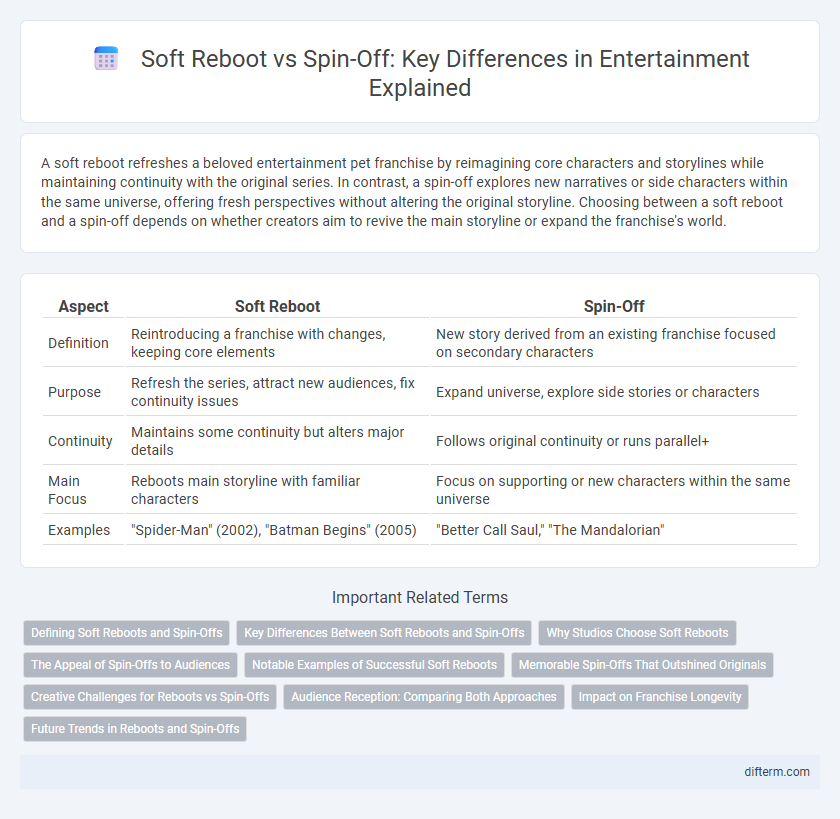A soft reboot refreshes a beloved entertainment pet franchise by reimagining core characters and storylines while maintaining continuity with the original series. In contrast, a spin-off explores new narratives or side characters within the same universe, offering fresh perspectives without altering the original storyline. Choosing between a soft reboot and a spin-off depends on whether creators aim to revive the main storyline or expand the franchise's world.
Table of Comparison
| Aspect | Soft Reboot | Spin-Off |
|---|---|---|
| Definition | Reintroducing a franchise with changes, keeping core elements | New story derived from an existing franchise focused on secondary characters |
| Purpose | Refresh the series, attract new audiences, fix continuity issues | Expand universe, explore side stories or characters |
| Continuity | Maintains some continuity but alters major details | Follows original continuity or runs parallel+ |
| Main Focus | Reboots main storyline with familiar characters | Focus on supporting or new characters within the same universe |
| Examples | "Spider-Man" (2002), "Batman Begins" (2005) | "Better Call Saul," "The Mandalorian" |
Defining Soft Reboots and Spin-Offs
Soft reboots refresh an existing franchise by updating storylines and characters while maintaining continuity with previous installments, often appealing to both new and returning audiences. Spin-offs explore secondary characters or subplots from the original series, creating distinct narratives that expand the universe without altering the main storyline. Both strategies allow studios to leverage established intellectual property while targeting varied viewer demographics in the entertainment industry.
Key Differences Between Soft Reboots and Spin-Offs
Soft reboots retain core characters and foundational plotlines while refreshing the story to attract new audiences, often resetting continuity without fully discarding previous installments. Spin-offs diverge by focusing on secondary characters or subplots, expanding the original universe with distinct narratives that may run parallel or independently. The key difference lies in soft reboots aiming to reimagine the original material for a fresh start, whereas spin-offs explore existing worlds from alternative perspectives or untold stories.
Why Studios Choose Soft Reboots
Studios choose soft reboots to revitalize established franchises while maintaining core elements that appeal to existing fans, balancing familiarity with fresh storylines. This strategy leverages brand recognition and reduces financial risks by retaining popular characters or settings, unlike spin-offs that often explore peripheral narratives with less guaranteed audience interest. Soft reboots also allow creative teams to update themes and visuals for contemporary audiences without alienating long-time followers.
The Appeal of Spin-Offs to Audiences
Spin-offs attract audiences by expanding beloved fictional universes and providing deeper backstories for secondary characters, enhancing viewer engagement. They offer fresh narratives while maintaining familiar elements, creating a balance between novelty and continuity. Fans often appreciate spin-offs for exploring unexplored themes and settings connected to original works.
Notable Examples of Successful Soft Reboots
Soft reboots in entertainment refresh established franchises by blending original storylines with new narratives, as seen in the Marvel Cinematic Universe's "Spider-Man: Homecoming" and the "Jurassic World" series. These adaptations preserve core elements while introducing contemporary themes and characters to attract both longtime fans and new audiences. Unlike spin-offs like "Better Call Saul," which explore side stories, soft reboots reimagine the main continuity to rejuvenate a franchise's appeal and commercial success.
Memorable Spin-Offs That Outshined Originals
Memorable spin-offs like "Better Call Saul" from "Breaking Bad" and "Frasier" from "Cheers" have outshined their original series by developing unique narratives and deeper character explorations. Unlike soft reboots that refresh existing franchises with updates and changes, spin-offs leverage established worlds to create entirely new story arcs and audiences. These successful spin-offs often achieve critical acclaim and cult status, proving the potential of expanding a beloved universe without altering its core continuity.
Creative Challenges for Reboots vs Spin-Offs
Reboots face creative challenges in balancing nostalgia with innovation, requiring fresh narratives that respect the original's legacy while appealing to new audiences. Spin-offs must develop compelling secondary characters and build unique storylines that expand the original universe without overshadowing or contradicting established lore. Both formats demand careful scriptwriting and character development to maintain fan engagement and avoid creative stagnation.
Audience Reception: Comparing Both Approaches
Audience reception of soft reboots often reflects a blend of nostalgia and curiosity, appealing to existing fans while attracting new viewers by updating familiar characters and storylines. Spin-offs generally receive mixed reactions as they explore secondary characters or new facets of the original universe, which can either deepen fan engagement or alienate those expecting a continuation of the main narrative. Metrics such as social media engagement, critical reviews, and box office performance frequently highlight the success of soft reboots in balancing innovation with legacy, whereas spin-offs depend heavily on the strength of their connection to the original franchise.
Impact on Franchise Longevity
Soft reboots refresh a franchise by reimagining key elements while retaining core characters and storyline, often revitalizing audience interest and extending the brand's lifespan without alienating existing fans. Spin-offs explore secondary characters or new storylines within the original universe, enriching the franchise's world-building and attracting niche audiences, which can diversify revenue streams and sustain long-term engagement. Both strategies contribute differently to franchise longevity by balancing innovation with familiarity, ensuring continued relevance in a competitive entertainment market.
Future Trends in Reboots and Spin-Offs
Future trends in reboots and spin-offs emphasize leveraging established universes while introducing fresh narratives that cater to evolving audience preferences and diverse demographics. Studios increasingly invest in digital streaming platforms to pilot spin-off series that expand character backstories and explore niche genres without risking theatrical box office performance. Data-driven content creation and fan engagement analytics guide the strategic development of soft reboots, ensuring a balance between nostalgia and innovation in entertainment franchises.
soft reboot vs spin-off Infographic

 difterm.com
difterm.com